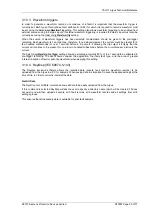
7SG11 Argus Technical Reference
©2013 Siemens Protection Devices Limited
P20007 Page 55 of 71
For a fault as shown, close to the load substation, the currents at breakers C and D will have similar levels and
their associated Argus relays will have prospective operate times of the same order. For the anti-clockwise fault
current flow through C, G FWD must be set to be faster than E REV which in turn must be faster than C (FWD).
Relay G will thus Trip first on FWD settings to stop the back feed of the fault, leaving D (FWD) to operate to clear
the fault and the un-faulted Feeder C maintains power to the load.
If the fault occurred on feeder C, then clockwise fault current will flow through D, E FWD must be set to be faster
than G REV which in turn must be faster than D. Relay E will thus Trip first on FWD settings to stop the back feed
of the fault, leaving C (FWD) to operate to clear the fault and the un-faulted Feeder D (FWD) maintains power to
the load.
Relays at C and D at the main substation could be set to non-directional but by setting them to be directional, the
bi-directional function enables different settings to be applied for feeder and busbar faults. At A and B, bi-
directional relays enable sensitive settings to be applied to the forward direction to detect transformer faults whilst
reverse settings can be graded with forward settings at C and D.
By using a single bi-directional Argus relay, with different settings for forward and reverse directions, complex ring
circuits can be set to grade correctly whether fault current flows in a clockwise or counter clockwise direction, i.e.
only one relay must be used where normally two relays are required. The same applies to Generator circuits.
L o a d
A
B
C
D
E
G
F a u lt
A rg u s A p p lic a t io n D ia g r a m s / P a r a lle l F d r P ro tn
Figure 3.2-1
Parallel Feeder Protection
3.3 Sensitive Earth-fault Protection
Where sensitive earth-fault settings are required, the setting must be above any line charging current levels that
can be detected by the relay.
On occurrence of an out of zone earth fault the elevation of sound phase voltage to earth in a non-effectively
earthed system can result in a zero sequence current of up 3 times phase charging current flowing through the
relay location.
The step change from balanced 3-phase charging currents to this level of zero sequence current includes
transients. It is recommended to allow for a transient factor of 2 to 3 when determining the limit of charging
















































